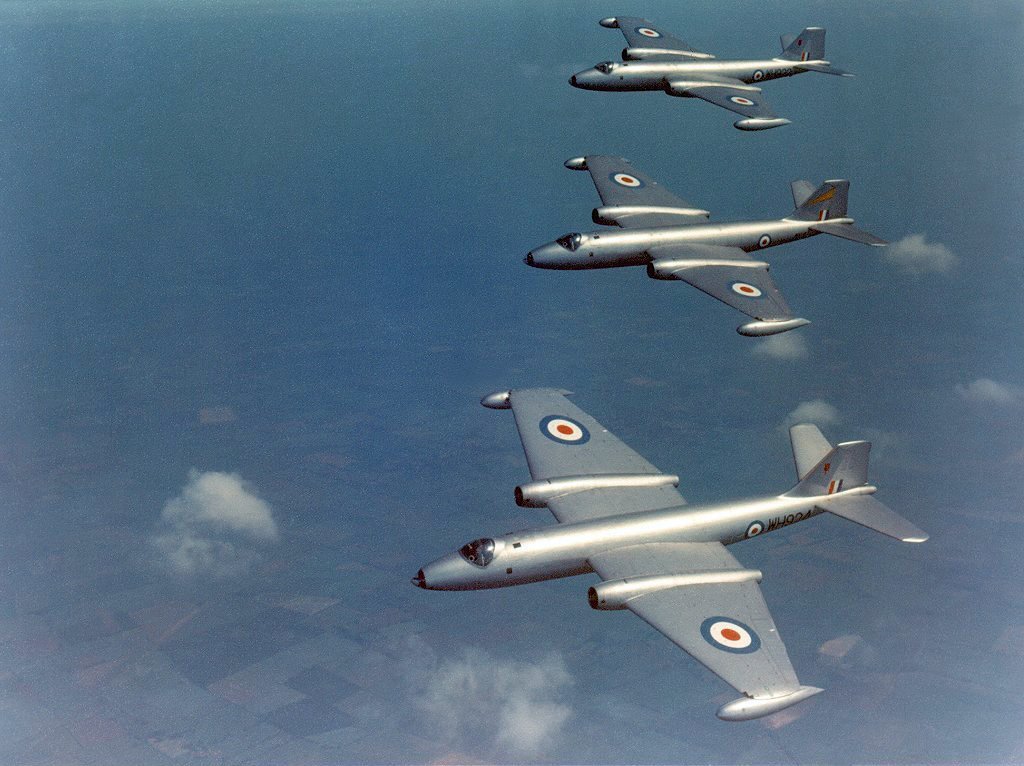“I decided to play a game and hard turned into the F-104s. Too late I remembered that the 100 series Avons fitted to the Canberra didn’t like that sort of treatment,” `Boz’ Robinson, former RAF Canberra pilot.
The RAF’s first jet bomber was the English Electric Canberra. It proved to be Britain’s most durable and long-serving frontline aircraft; 57 years after the prototype’s first flight, a few reconnaissance PR 9s are still in service. Throughout its lifetime, the type equipped over 40 squadrons, and 546 examples were produced. Except for its bomb load, the Canberra was built for speed and carried no additional weaponry. Its low-aspect wing allowed for exceptional fuel economy at a maximum cruise altitude well above that of modern NATO fighters. This meant Canberra was safe from manned interception for several years before the development of air-to-air missiles.
RAF Akrotiri Canberras (there were five Canberra squadrons deployed to Akrotiri: No. 6 Squadron, No. 32 Squadron, No. 73 Squadron, No. 249 Squadron, and No. 13 Squadron with its PR 9s) also provided fighter affiliation targets for Central Treaty Organisation (CENTO) air forces to pit their wits against. Lightning F 3s from No 56 Sqn, Turkish F-100 Super Sabres, and Iranian F-4s were all routinely exercised with, and `Boz’ Robinson also deployed to Pakistan in May 1963 to provide practice intercept training for the Pakistani Air Force (PAF), as he recalls in Andrew Brookes’ book RAF Canberra Units of the Cold War;
`The PAF requested that we remain below 40,000 ft, but when Canberra had used up half of its fuel, it could have cruise-climbed much higher. As a fighter pilot, I thought it would be a good idea to even the score a little and, despite the briefing, climbed with my No. 2, Dave Willis, toward 48.000 ft. My navigators were working hard, one keeping us on track, the other helping me with the lookout to spot the incoming fighters. Suddenly, I saw two F-104s way below the left wing, and without any hope of carrying out an intercept on us. In those days there was no air-to-air missile threat from those F-104s, so their only chance of a kill would have been from a gun attack.
`I decided to play a game and hard turned into the F-104s. Too late, I remembered that the 100-series Avons fitted to the Canberra didn’t like that sort of treatment. There were two loud pops and then silence! I had flamed out both engines and would now have to descend to below 20,000 ft to relight them. News of our escapade in northern Pakistan, coupled with the loss of a No. 6 Sqn B 16 and its crew of three caught in a cumulo-nimbus in the vicinity of Khartoum, convinced my colleagues that the 100 series Avon required careful handling above 40,000 ft.
`We spent much of our time as a crew doing nuclear target study. Our target was a large city on the west coast of the Caspian Sea inside the Soviet Union — a place I visited in my later role as British air attache in Moscow. After so many years, it is hard to remember exactly one’s feelings about being a nuclear bomber. I don’t think we lost much sleep over the fact.’

RAF Canberra Units of the Cold War is published by Osprey Publishing and is available to order here.
Photo by Crown Copyright and Pakistan Air Force

